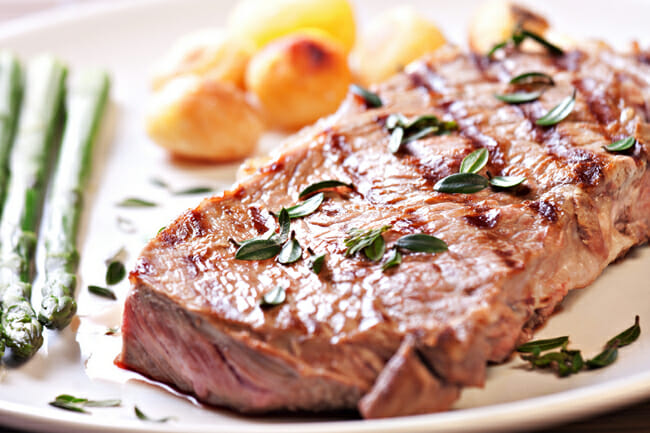I’ve heard rumblings about the paleo diet for years, but only now realize that “eating like a caveman” is more than just a passing fancy. Friends are hooked on the paleo program, a new caveman book seems to appear every time I pop into my local bookstore, and paleo recipe sites dominated the recent “best healthy food blog” contest on the popular website The Kitchn. It’s clear that the stone age diet is here to stay, which feels like high time for me to weigh in.
What is a Paleo Diet?
Paleo is based on what is believed to have been the diet during Paleolithic times: meat and fish acquired through hunting and fishing, and nuts, fruits, and vegetables, acquired through gathering. This translates in modern day to a diet that includes meat, preferably grass-fed, game, poultry, preferably pastured, wild seafood, eggs, fruits, vegetables, seeds, nuts, certain oils including olive, coconut, and walnut oil, and for some paleo followers, honey and maple syrup in moderation.
Foods that are not “paleo-approved” include grains, legumes, potatoes, dried beans, dairy foods, refined sugar, salt, processed foods, artificial ingredients.
Upside of a Paleo Diet
The paleo approach to eating offers much to be desired from a health standpoint. Indeed, it would be a very good thing if a few of the fundamentals were to rub off on the American public. Here’s where I applaud the diet:
- Reliance on whole foods without processed ingredients.
- Eschewing refined sugar, something we eat far too much of in this country.
- Emphasis on high-quality animal protein: grass fed beef, pastured chickens, and wild seafood. These foods tend to be higher in nutrient content and gentler on the environment than conventionally raised beef and poultry, as well as farmed fish.
- High intake of fruits and vegetables. Because the diet eliminates grains and beans, it relies heavily on fruits and vegetables, which are low calorie, nutrient-rich, and far too inadequate in the typical American diet.
- Innovative approach to cooking. Many foods traditionally used in recipes are not part of the Paleo lifestyle. This, by default, has give rise to some pretty inspired food and use of ingredients.
Some Drawbacks
On the flip side, though, there are a number of sticking points:
- The idea of knocking out entire categories of nourishing ingredients just doesn’t stack up: Quinoa, farro, oats, lentils, chick peas, peanuts, and yogurt. Mountains of research demonstrate the health benefits of all of these foods and their role in disease reduction.
- Eliminating affordable ingredients such as grains and beans, and prescribing grass fed meat and pastured chicken makes this diet an expensive proposition that is, frankly, out of reach for much of the country, not to mention the world at large, most of which subsists on these forbidden foods.
- Animal protein, even when sustainably raised, is more taxing to the environment than plant-based proteins, such as beans and grains. Many animal proteins are high in saturated fat, which we know to be linked to high cholesterol and heart disease.
- The adverse effects of salt are associated with an excess intake largely from processed food. Used in moderation in home cooking, salt is perfectly compatible with good health.
- Meeting all the important nutritional requirements could prove challenging on the Paleo diet.
The Deeper Issue with Limiting Foods
Nutrition data aside, here’s where I get really stuck:
Any diet that claims to be the cure-all for what ails us, quite simply, gives me hives. I don’t espouse a “one-size fits all” approach to eating, so the statement by self-proclaimed paleo founder Dr. Loren Cordain that his is “the healthiest diet in the world,” doesn’t ring true.
Travel abroad and you’ll discover pockets of the globe where inhabitants know little of the diseases that afflict modern society. Each group eats a vastly different diet. This notion is the basis for Dr. Daphne Miller’s acclaimed book, The Jungle Effect. Consider for example, the Tarahumara Indians in Copper Canyon Mexico for whom diabetes and cancer is practically non-existent. They subsist on a foundation of beans and corn, foods considered off limits to paleo followers. Or look at the traditional cuisine of Crete, a Greek Island with a remarkably low rate of heart disease. Theirs is a diet that includes barley and yogurt, with very little meat. Again, a significant departure from the paleo approach.
Aren’t these possibly some of the “best diets in the world,” too?
Perhaps as important as any of the nutrition, environmental, or economic arguments is what I think of as the flavor quotient. Following a paleo diet means that many delicious, nourishing dishes that find their way to my dinner table would be off limits: braised farro with winter greens and mushrooms, slow cooked white bean soup with a smoky ham hock, apple slices topped with peanut butter and homemade granola, and a luscious raspberry smoothie boosted with Greek yogurt.
That just makes no sense to me.
I have friends who swear by paleo and have both lost weight and feel terrific on it. And I say, good for them. But for now, I’ll stick with my own “best diet” by making a salad on a bed of quinoa with greens and chickpeas, topping it with crumbled feta, tossing it with a yogurt dressing, and enjoying it with a slice of hearty, whole grain bread with a swipe of salty butter.
You?
